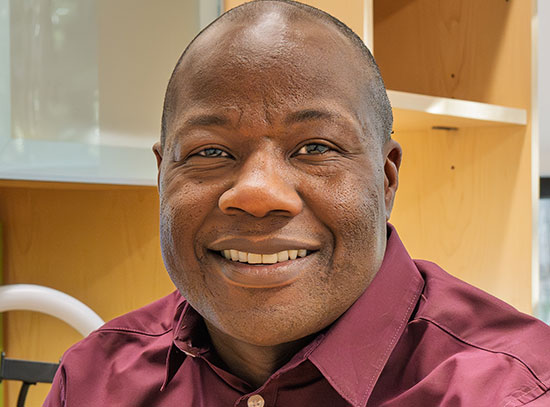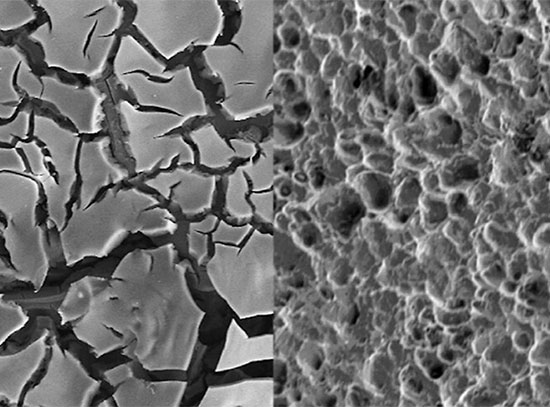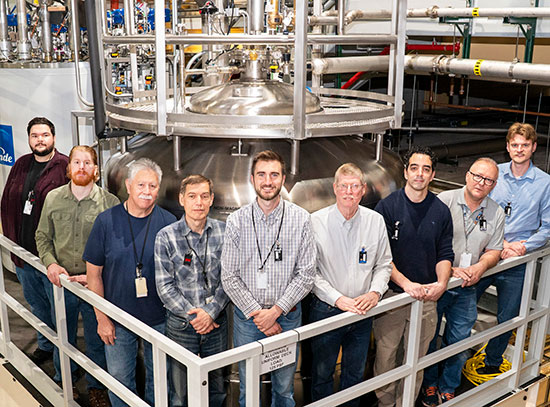25 Years Since First Collisions at the Relativistic Heavy Ion Collider
Reflections on the collider's origins, initial discoveries, and lasting impact
June 12, 2025
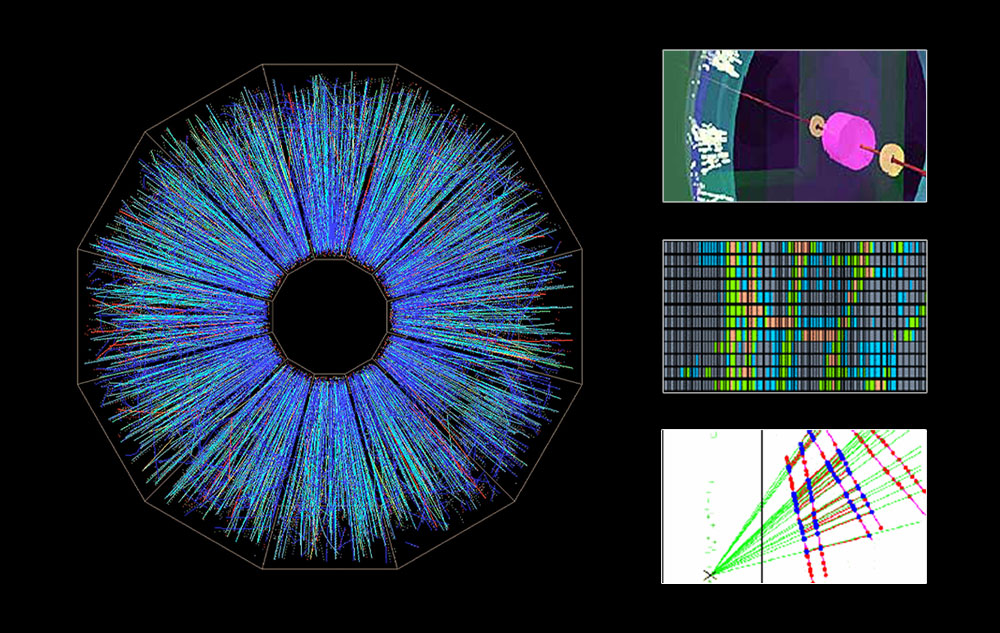 enlarge
enlarge
Images showing the tracks of thousands of subatomic particles streaming from collisions at the Relativistic Heavy Ion Collider (RHIC) lit up display monitors at the STAR detector for the first time on June 12, 2000. All four RHIC detector were recording collisions by Friday, June 15 (insets top to bottom: PHENIX, BRAHMS, PHOBOS).
Twenty-five years ago tonight, at just about 9 p.m. in Upton, New York, the Relativistic Heavy Ion Collider (RHIC), began colliding gold ions for the first time. The startup of this flagship U.S. Department of Energy (DOE) Office of Science user facility at DOE’s Brookhaven National Laboratory marked the beginning of a new era in nuclear physics research.
Since then, RHIC has produced nearly 100 trillion particle collisions using a dozen different combos of atomic nuclei from protons to uranium. These particle smashups have occurred over energies ranging from 7.7 billion electron volts (GeV) up to 200 GeV — and even at an initially unplanned but extremely interesting low energy (3 GeV), produced by firing gold nuclei into a stationary target placed inside STAR, one of RHIC’s house-size particle detectors. RHIC has also operated as the world’s first and only polarized proton collider, providing beams of precisely oriented protons for exploring the mystery of proton spin.
Thousands of scientists from around the world have used data recorded from this wide variety of collisions to explore quarks and gluons, visible matter’s most fundamental building blocks; map out the phases of nuclear matter; and investigate the origins of proton spin — sharing their findings in nearly 700 scientific publications and more than 800 contributions to conference proceedings.
 enlarge
enlarge
William Zajc, a physics professor at Columbia University who served as the first spokesperson for the PHENIX experiment at the Relativistic Heavy Ion Collider (RHIC). (Columbia University)
“That a single collider can be operated at so many different energies, with different nuclear species including polarized protons, makes RHIC the most versatile collider ever,” said Abhay Deshpande, Brookhaven Lab’s associate laboratory director for nuclear and particle physics. “It is also a testament to the imagination and expertise of the accelerator scientists who designed and operate this facility. RHIC has made possible one of the most diverse and comprehensive physics programs aimed at exploring the fundamental properties of nuclear matter over the past 25 years.”
At a celebratory symposium held on May 22 during the 2025 RHIC & AGS Users’ Meeting, William Zajc — a physics professor at Columbia University who served as spokesperson for RHIC’s PHENIX experiment at the time — reflected on the collider’s origins and its first discoveries.
“I thought I would go back not 25 years but 75 years, three quarters of a century, because, indeed, in 1950, [Enrico] Fermi laid the groundwork for, in effect, our field.” Zajc pointed out a paper in which the famous physicist expressed interest in statistical approaches to understanding particle production, and a hand-drawn diagram mapping out phases of matter in notes from a course Fermi taught that were published in 1952. While Zajc noted that RHIC’s studies of nuclear matter have exceeded even Fermi’s vision, he said, “I think we’ve done an extremely good job in mapping out the characteristics of what he termed ‘matter under unusual conditions.’”
Among the other historic milestones Zajc noted was a workshop convened by theorist T.D. Lee with help from Leon Lederman in 1974, designed to address “the possible existence of a nuclear world quite different from the one we have learned to accept as familiar and stable,” according to the preface from the published proceedings. In a talk at that conference, Lee laid out the idea of an experiment for exploring nuclear matter with high density over a relatively large volume. “The fact that such directions have never been explored should by itself serve as an incentive for doing such experiments,” Lee said.
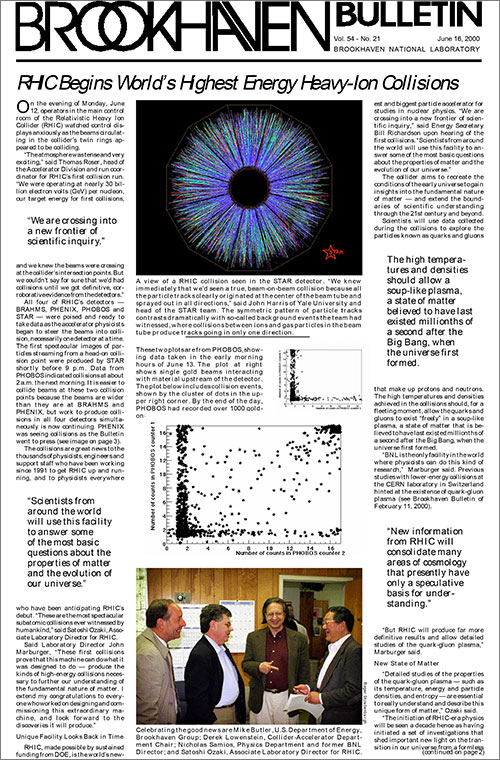 enlarge
enlarge
June 16, 2000, issue of the Brookhaven Bulletin announcing first collisions at the Relativistic Heavy Ion Collider (RHIC). Read the full issue.
Zajc noted that these ideas arose without mention of quarks or gluons or the quark-gluon plasma (QGP) — a central quarry of RHIC’s collisions — because the theory that would eventually describe those concepts was only then just being developed. But by 1983 — referred to as a foundational year in a recent review article by Zajc and Wit Busza, an MIT professor and former spokesperson for PHOBOS, an early RHIC detector — events and ideas converged. Zajc conveyed how discussions about experiments that might explore this unique form of nuclear matter coincided with the cancellation of a different planned collider at Brookhaven, leaving an empty tunnel and partially constructed cryogenic facilities available for a quick pivot. Zajc recounted the story of how “visionary leaders” at Brookhaven proposed and gained support to fill that tunnel with the world’s first purpose-built heavy ion collider — RHIC.
RHIC’s top energy of 200 GeV turned out to be fortuitous for making crucial discoveries, Zajc noted. But not before a bit of a kerfuffle when CERN, the European Laboratory for Nuclear Research, announced it had created a new form of matter “in which quarks … are liberated to roam freely,” just as RHIC was about to turn on to create and study the very same stuff!
Zajc recalled how the CERN claim, which lacked the scrutiny normally required for announcing such scientific discoveries, motivated the RHIC scientists and Brookhaven Lab to follow a more formal pathway to their own eventual announcement that RHIC had created the QGP. He described key findings presented at the January 2001 Quark Matter meeting at Stony Brook University, the first since RHIC had turned on, as consistent with a QGP. But there were some surprises and a desire among physicists to be more certain. That hesitancy persisted even after more telling results were presented at the Quark Matter meeting in 2004, covered in two stories by James Glanz of The New York Times.
After sharing a few colorful quotes from the second Times story, Zajc said, “It’s no surprise that Berndt Mueller [a theoretical physicist at Duke University who later became the associate laboratory director running the RHIC program at Brookhaven] offered a very measured response that I would endorse entirely. He says, ‘It’s no mystery to me why they haven’t announced it [the discovery of the QGP]. I think the lab has been appropriately cautious.’”
Watch the video of William Zajc's whole talk or see his slides.
Eventually, the spokespersons for all four RHIC experiments — STAR, PHENIX, PHOBOS, and BRAHMS — decided to publish their collected results related to the QGP search simultaneously in peer-reviewed white papers. That led to the April 2005 “perfect” liquid announcement at the American Physical Society meeting, Zajc recounted. He noted that this new form of matter was quite different and more intriguing than the one CERN had claimed because its liquidlike properties implied that “liberated” quarks are not roaming freely but instead interact and move together.
Since then, Zajc said, “The paradigm of the RHIC perfect liquid has prevailed and discoveries continue to flow … We can now confidently attest to the uniqueness of the QGP” as definitively discovered and characterized at RHIC.
Brookhaven National Laboratory is supported by the Office of Science of the U.S. Department of Energy. The Office of Science is the single largest supporter of basic research in the physical sciences in the United States and is working to address some of the most pressing challenges of our time. For more information, visit science.energy.gov.
Follow @BrookhavenLab on social media. Find us on Instagram, LinkedIn, X, and Facebook.
2025-22486 | INT/EXT | Newsroom




